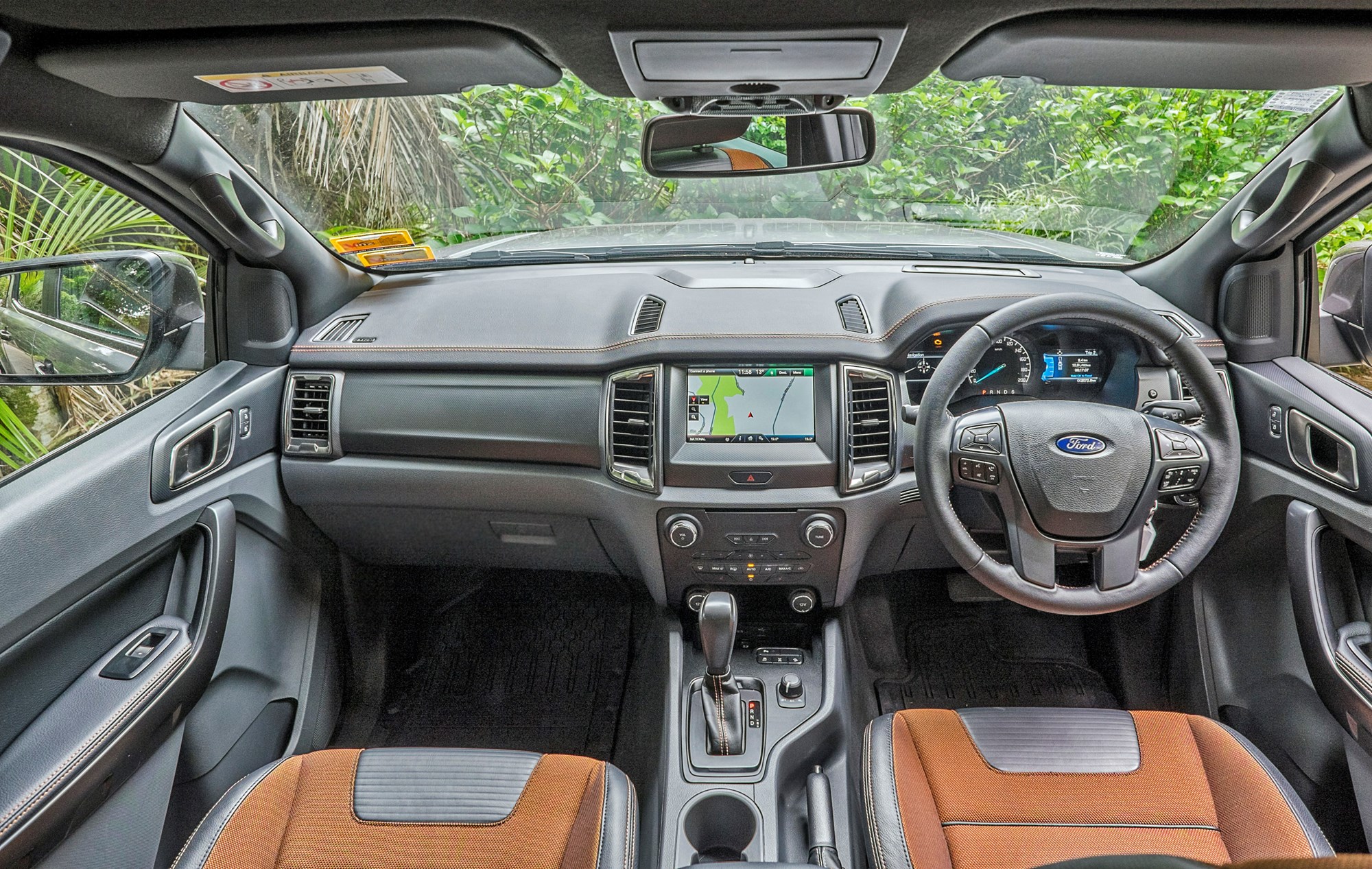WHAT’S THE DIFFERENCE BETWEEN TWO VERSIONS OF THE SAME UTE? PHIL HANSON HAS THE ANSWERS
Car companies usually promote top-end models, the ones with all the gear and styling add-ons, and mumble about the entry-level versions: “Oh yeah, we’ve got them too, but they’re for fleet customers.”
‘Fleet’ may be spoken with a slight sneer, depending whether the salesperson does business in that sector.
So what are baseline buyers missing by not digging deep for the big price tags but opting for a base vehicle?

The “Remuera” Ranger — the Wildtrak 4WD, chock-full of features and equipment you might expect to find in a European luxury car, not a mere one-tonne truck.
Let’s say a ute like the facelifted Ford Ranger that has one set of wheels in the luxury car market, the other on the building site.
More important, how much does the missing stuff that you’re not paying for really matter?
In one corner, from Remuera, the Ranger Wildtrak 4WD, the best-dressed Ranger money can buy, chock-full of the features and equipment you might expect to find in a European luxury car, not a mere one-tonne truck.
In the other corner, from Manurewa, an XL supercab with manual transmission, the cheapest 4WD Ranger you can buy with a wellside tray, $15,500 less than the Wildtrak. This one was painted quite a classy shade of grey, but it’s as blue-collar as you can get from the Ford NZ ute lineup.

The “Manurewa” Ranger — an XL supercab with manual transmission, the cheapest 4WD Ranger you can buy with a wellside tray, as blue-collar as you can get. Wildtrak’s tonneau cover is close to an ideal solution for load protection and security.
Driven has two enduring memories of its time with the Wildtrak. One is the best-looking, best thought-out interior of any ute on the NZ market.
This includes a large information/navigation screen and clever instrument panel graphics.

The interior of the Ford Ranger Wildtrak (above)
For example, when the driver moves the automatic into sport mode, a virtual tachometer magically replaces a panel that usually displays such information as fuel consumption. Move back into drive and the pretend-tach slides left and exits. So clever, it makes you want one.
The other memorable feature is the clever roller tonneau cover for the cargo tray. Built by Mountain Top of Denmark, it’s close to an ideal solution for load protection and security.
An alloy version of the grandparents’ roller desk cover,it seemingly vanishes into nowhere as it’s pushed forward. Many locking positions allow part of the tray to be covered, the other part open as the need dictates.
It’s a brilliant alternative to a low-security, easily damaged vinyl tonneau cover, or those hard one-piece lift-ups. Dealers can also fit a Mountain Top to XL and XLT Rangers.
There’s no chance of mistaking the 3.2-litre five-cylinder engine for anything other than a diesel but Ford is correct when it says the latest version is both quieter and smoother. It’s a soothing highway cruiser. For manual-transmission drivers, a new linkage and other revisions to the six-speed make it better to use.
Most manuals have an auto stop-start feature that switches off the engine when the vehicle is stationary, saving fuel and lowering overall CO2 emissions. Unlike some diesels with this feature, it works very smoothly.
Clever stop-start aside, getting into the XL from a Wildtrak is initially a bit of a shock. Gone are the clever dashboard graphics; the big screen replaced by one about the size of a cigarette package.

The Ranger XL interior
There’s no satnav, no reversing camera (you don’t realise how good an aid a decent reversing camera can be until it’s not there), no fancy stitching on the dash and seats. No lane warning and blind-spot alert gizmos. The radio and aircon switches look kind-of cheap.
But don’t panic. The power-adjustable mirrors are still there, along with power windows, cruise control, the 240v power inverter and Ranger’s core safety and technology features, including hill descent control.
Outside, the XL loses most of the Wildtrak’s fancy trim and replaces 18-inch alloys with 16-inch steels. Wildtrak handles slightly better with its more road-friendly 265 x 50 18-inch Bridgestone Dueler HT 684 II tyres. The XL rides on the same tyre, but a more worksite-oriented 255 x 70 size.
And the XL adds a couple of important tray features missing on the Wildtrak. Not only does the base model have half a dozen load-area tie-down points, but a set of four hefty securing points on each exterior side. It also has a headboard that’s so useful for both protecting the cab and helping secure long loads, like timber, pipe or ladders.
 It doesn’t take long to realise that it’s not what’s missing that defines the XL, which some might regard as a price-leader to tempt buyers into more-expensive models. What defines the XL is how much gear it does have for a truck that’ll be out working for a living.
It doesn’t take long to realise that it’s not what’s missing that defines the XL, which some might regard as a price-leader to tempt buyers into more-expensive models. What defines the XL is how much gear it does have for a truck that’ll be out working for a living.
Its general specification level would have been considered luxurious on a ute a few years ago and, even now, most families would be happy to have it as a weekend runabout.
The XL, even more than the glamorous Wildtrak, provides one insight into why Ford now has the country’s top-selling utility.
PROS & CONS FORD RANGER XL SUPERCAB
| PRICE: | $54,140 |
| ENGINE: | 3.2-litre five-cylinder turbodiesel, 147kW/470Nm |
| PROS: | A good, honest ute |
| CONS: | Squabs on rear “occasional” seats feel a bit cheap |















